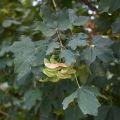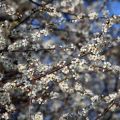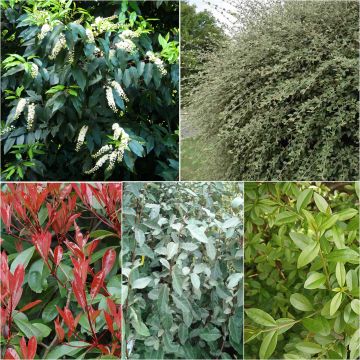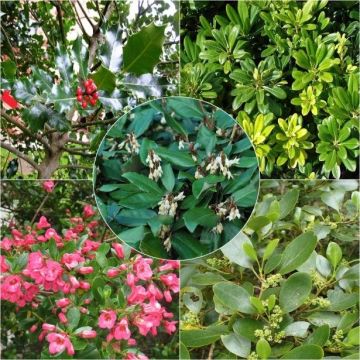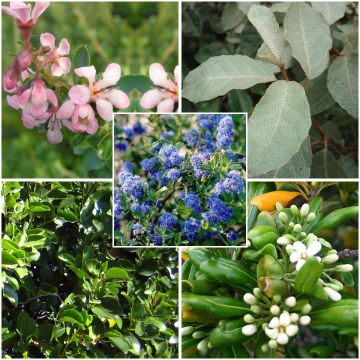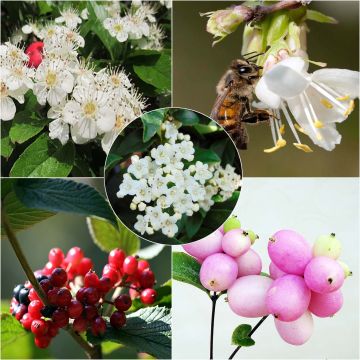

Regional hedge for the Grand Est and Burgundy region in a 5m (16ft) kit
Regional hedge for the Grand Est and Burgundy region in a 5m (16ft) kit
Very good idea to have selected young plants for our region East Burgundy, limestone soil, temperature -15° (5°F). Hope to have a good follow-up for a choice of plants for our region; colourful, fragrant, sun to partial shade exposure.... Thank you....
Ode, 25/09/2021
This item cannot be shipped to the selected country
Delivery charge from €5.90
More information
Schedule delivery date,
and select date in basket
This plant carries a 24 months recovery warranty
More information
We guarantee the quality of our plants for a full growing cycle, and will replace at our expense any plant that fails to recover under normal climatic and planting conditions.
From €5.90 for pickup delivery and €6.90 for home delivery
Express home delivery from €8.90.
Does this plant fit my garden?
Set up your Plantfit profile →
Collection items (5 plants)
Description
The Regional Hedge for the Grand East and Burgundy has been designed for gardeners who want to create a worry-free hedge that showcases native species perfectly adapted to the harshness of these regions. In this beautiful French region governed by a clearly continental climate, summers are hot, even scorching, and winters are very cold and snowy. The soils are frequently limestone, sometimes marly, not always easy to work with and enhance. The selection we offer you brings together 5 small trees or large bushes that perfectly withstand these difficult conditions. In addition to these qualities, they have the undeniable charm of their autumn colors, their often fragrant flowering, and their berries sought after by birds that will brighten the shortest and saddest days of the year. This kit allows you to create a hedge of about 5 metres (16 feet) long.
It consists of:
- 1 Acer campestre - Field Maple: a small tree with a rounded and dense habit, slow-growing, which reaches up to 8 metres (26 feet) in height and 4 metres (13 feet) in width, deciduous in winter, appreciated above all for its beautiful autumn colors in shades of yellow-copper. The very discreet flowering takes place in spring, at the same time as the leaves appear. The small flowers are greenish and give way to winged fruits often reddish, called samaras. Very common in our French forests, this maple is really easy to grow in any soil, and it tolerates pruning very well, which allows it to be kept in moderate dimensions.
- 1 Amelanchier laevis Ballerina: a tall deciduous shrub with a regular and spreading habit, slow-growing, which reaches about 5 metres (16 feet) in height and 3 metres (10 feet) in width. Both undemanding and ornamental, it is interesting for the beauty of its young shoots tinged with bronze, its generous spring flowering with large pure white star-shaped flowers, its edible and tasty fruits the size of a blueberry, and its flamboyant autumn colors in a palette of red, orange, and purple.
- 1 Crataegus monogyna - Common Hawthorn. A large, thorny and deciduous shrub that can reach 7 metres (23 feet) in height and 8 metres (26 feet) in width if not pruned. Its white and highly fragrant flowers, grouped in flat heads, bloom in May, much to the delight of pollinating insects. They give way to red fruits called haws, which will be consumed by birds throughout autumn. The hawthorn adapts everywhere.
- 1 Viburnum lantana - Wayfaring Tree, Mancienne. A deciduous shrub species with a bushy habit, reaching 4 to 5 metres (13 to 16 feet) in height and 2 to 3 metres (7 to 10 feet) in width. Its abundant flowering, which takes place from April to June, takes the form of clusters of cream-white flowers pleasantly scented with orange blossom. Its small, round, black fruits persist on the branches for much of the winter, delighting birds.
- 1 Prunus spinosa - Blackthorn. A symbol of vigor and robustness, this large bushy and thorny deciduous shrub is a familiar sight in our landscapes, animating them with a beautiful white spring flowering. It is also known for its black and edible fruits, sloes. This light-loving species is a robust pioneer plant, very hardy, fairly fast-growing, but also slightly suckering. If left unpruned, the blackthorn will reach approximately 3.50 metres (11 feet) in all directions.
These small trees create a charming countryside atmosphere in the company of other native species such as medlar, European spindle, privet, and hornbeam. They can be planted on the property boundary, creating a pleasant transition with the countryside. To enhance the base of your hedge, for example, plant some spring bulbs.
Plant these shrubs in full sun or partial shade, in ordinary but well-prepared soil, mixing them and spacing them 1 metre (3 feet) apart. It is best to avoid pruning this natural hedge, to avoid compromising flowering and fruiting. If you need to intervene, avoid doing so during the nesting season. Proceed on a case-by-case basis, shortening the branches of shrubs that become too large.
Report an error about the product description
Plant habit
Flowering
Foliage
Botanical data
Cultivar or hybrid
Other Hedge-growing kits A to Z
Planting and care
Plant this kit in full sun or partial shade, in a well-prepared but ordinary soil. Very easy to grow and highly adaptable, these bushes require only one maintenance when they are young, which is mulching in summer to maintain a certain level of moisture. Water them in the first few years in case of marked drought. Once well established, they will manage on their own in all regions. You can prune the longest branches to help your bushes branch out. However, avoid pruning that limits flowering and fruiting, unless your bushes become too large. Prune outside the bird nesting period (from March to June-July).
Planting period
Intended location
Care
-
, onOrder confirmed
Reply from on Promesse de fleurs
Hedge shrubs
Haven't found what you were looking for?
Hardiness is the lowest winter temperature a plant can endure without suffering serious damage or even dying. However, hardiness is affected by location (a sheltered area, such as a patio), protection (winter cover) and soil type (hardiness is improved by well-drained soil).

Photo Sharing Terms & Conditions
In order to encourage gardeners to interact and share their experiences, Promesse de fleurs offers various media enabling content to be uploaded onto its Site - in particular via the ‘Photo sharing’ module.
The User agrees to refrain from:
- Posting any content that is illegal, prejudicial, insulting, racist, inciteful to hatred, revisionist, contrary to public decency, that infringes on privacy or on the privacy rights of third parties, in particular the publicity rights of persons and goods, intellectual property rights, or the right to privacy.
- Submitting content on behalf of a third party;
- Impersonate the identity of a third party and/or publish any personal information about a third party;
In general, the User undertakes to refrain from any unethical behaviour.
All Content (in particular text, comments, files, images, photos, videos, creative works, etc.), which may be subject to property or intellectual property rights, image or other private rights, shall remain the property of the User, subject to the limited rights granted by the terms of the licence granted by Promesse de fleurs as stated below. Users are at liberty to publish or not to publish such Content on the Site, notably via the ‘Photo Sharing’ facility, and accept that this Content shall be made public and freely accessible, notably on the Internet.
Users further acknowledge, undertake to have ,and guarantee that they hold all necessary rights and permissions to publish such material on the Site, in particular with regard to the legislation in force pertaining to any privacy, property, intellectual property, image, or contractual rights, or rights of any other nature. By publishing such Content on the Site, Users acknowledge accepting full liability as publishers of the Content within the meaning of the law, and grant Promesse de fleurs, free of charge, an inclusive, worldwide licence for the said Content for the entire duration of its publication, including all reproduction, representation, up/downloading, displaying, performing, transmission, and storage rights.
Users also grant permission for their name to be linked to the Content and accept that this link may not always be made available.
By engaging in posting material, Users consent to their Content becoming automatically accessible on the Internet, in particular on other sites and/or blogs and/or web pages of the Promesse de fleurs site, including in particular social pages and the Promesse de fleurs catalogue.
Users may secure the removal of entrusted content free of charge by issuing a simple request via our contact form.
The flowering period indicated on our website applies to countries and regions located in USDA zone 8 (France, the United Kingdom, Ireland, the Netherlands, etc.)
It will vary according to where you live:
- In zones 9 to 10 (Italy, Spain, Greece, etc.), flowering will occur about 2 to 4 weeks earlier.
- In zones 6 to 7 (Germany, Poland, Slovenia, and lower mountainous regions), flowering will be delayed by 2 to 3 weeks.
- In zone 5 (Central Europe, Scandinavia), blooming will be delayed by 3 to 5 weeks.
In temperate climates, pruning of spring-flowering shrubs (forsythia, spireas, etc.) should be done just after flowering.
Pruning of summer-flowering shrubs (Indian Lilac, Perovskia, etc.) can be done in winter or spring.
In cold regions as well as with frost-sensitive plants, avoid pruning too early when severe frosts may still occur.
The planting period indicated on our website applies to countries and regions located in USDA zone 8 (France, United Kingdom, Ireland, Netherlands).
It will vary according to where you live:
- In Mediterranean zones (Marseille, Madrid, Milan, etc.), autumn and winter are the best planting periods.
- In continental zones (Strasbourg, Munich, Vienna, etc.), delay planting by 2 to 3 weeks in spring and bring it forward by 2 to 4 weeks in autumn.
- In mountainous regions (the Alps, Pyrenees, Carpathians, etc.), it is best to plant in late spring (May-June) or late summer (August-September).
The harvesting period indicated on our website applies to countries and regions in USDA zone 8 (France, England, Ireland, the Netherlands).
In colder areas (Scandinavia, Poland, Austria...) fruit and vegetable harvests are likely to be delayed by 3-4 weeks.
In warmer areas (Italy, Spain, Greece, etc.), harvesting will probably take place earlier, depending on weather conditions.
The sowing periods indicated on our website apply to countries and regions within USDA Zone 8 (France, UK, Ireland, Netherlands).
In colder areas (Scandinavia, Poland, Austria...), delay any outdoor sowing by 3-4 weeks, or sow under glass.
In warmer climes (Italy, Spain, Greece, etc.), bring outdoor sowing forward by a few weeks.

































